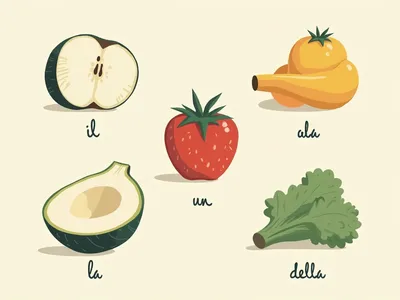
How do Italian articles differ from English articles
Learn Essential Italian Vocabulary for Beginners – A1 Level: How do Italian articles differ from English articles
Italian articles differ from English articles in several significant ways, particularly in their forms, usage, and grammatical rules. Below is a detailed comparison:
Key Differences Between Italian and English Articles
1. Variety of Forms
- Italian: Italian articles are more numerous and variable compared to English. They change based on the gender (masculine or feminine) and number (singular or plural) of the noun they precede. For example:
- Definite articles (equivalent to “the”): il, lo, la, l’, i, gli, le.
- Indefinite articles (equivalent to “a” or “an”): un, uno, una, un’.
- Partitive articles (equivalent to “some” or “a few”): del, dello, della, dell’, dei, degli, delle.
- English: English has only three articles: the definite article “the” (used for both singular and plural nouns) and the indefinite articles “a” and “an” (used for singular nouns only) 1, 4, 7.
2. Agreement with Gender and Number
- Italian: Articles must agree in gender and number with the noun they modify. For instance:
- Masculine singular: il libro (“the book”).
- Feminine singular: la casa (“the house”).
- Masculine plural: i libri (“the books”).
- Feminine plural: le case (“the houses”).
- English: Articles do not change form regardless of the noun’s gender or number. For example, “the book” and “the books” use the same article 1, 3, 7.
3. Usage Frequency
- Italian: Articles are used far more frequently in Italian than in English. Italian requires articles in many contexts where English omits them. For example:
- Days of the week: Il lunedì vado in palestra (“I go to the gym on Mondays”).
- Languages: L’italiano è facile da imparare (“Italian is easy to learn”).
- Generalizations: La pazienza è una virtù (“Patience is a virtue”).
- English: Articles are often omitted in similar cases, especially with generalizations or languages 1, 2, 6.
4. Use with Proper Nouns
- Italian: Definite articles are sometimes used with proper nouns, especially when referring to famous people or geographical entities. For example:
- Il Dante (“Dante”) or La Francia (“France”).
- English: Articles are typically not used with proper nouns unless referring to specific cases like “the United States” or “the Nile” 1, 6.
5. Possession and Specific References
- Italian: Definite articles replace possessive adjectives when referring to body parts, clothing, or personal belongings. For example:
- Ho le mani sporche (“My hands are dirty,” literally “I have the hands dirty”).
- Laura indossa la giacca (“Laura is wearing her jacket,” literally “Laura is wearing the jacket”).
- English: Possessive adjectives like “my” or no article at all are used instead 2, 5.
6. Partitive Articles
- Italian: Partitive articles (del, della, etc.) indicate an unspecified quantity of something (e.g., “some water”). For example:
- Vorrei del pane (“I would like some bread”).
- English: The equivalent expression uses words like “some” or omits the article entirely 3, [8].
Summary Table
| Feature | Italian | English |
|---|---|---|
| Number of Forms | Many (15 forms) | Few (3 forms) |
| Gender & Number Agreement | Required | Not required |
| Frequency of Use | More frequent | Less frequent |
| Use with Proper Nouns | Common | Rare |
| Possession | Uses definite articles | Uses possessive adjectives |
| Partitive Articles | Present (del, della, etc.) | Uses “some” or omits |
In conclusion, while both languages use articles to introduce nouns and clarify specificity, Italian’s system is more complex due to its gendered and pluralized forms as well as its broader usage across various contexts. These differences can be challenging for English speakers learning Italian but are essential for mastering the language’s grammar and fluency.